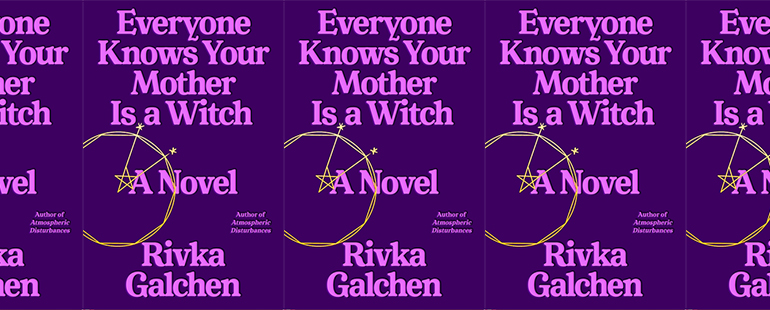The Allure of Scapegoating in Everyone Knows Your Mother Is a Witch

Everyone Knows Your Mother Is a Witch
Rivka Galchen
Farrar, Straus and Giroux | June 8, 2021
In Rivka Galchen’s first novel, Atmospheric Disturbances, a psychiatrist believes an imposter has replaced his wife. Desperate to discover the whereabouts of his “real” wife, he travels to Argentina and Patagonia, letting obscure doppelgänger research inform his quest. But the supposed “double” wife, as he calls her, is obviously not an imposter but his actual wife—and naturally, she’s alarmed by her husband’s insanity. The narration’s unreliability allows the reader to see around the psychiatrist while also somehow submitting to his rigorous scientific conceptions of unreality. It’s a demanding, whimsical novel that obscures subjectivity and objectivity, presenting an alternative experience of truth through one man’s delusion.
Galchen’s new novel, Everyone Knows Your Mother Is a Witch, adopts a wider historical lens to interrogate unreliability. Set in a German duchy in the early 1600s amid a plague and the Thirty Years’ war, the book centers around Katharina Kepler, an illiterate elderly widow accused by her neighbors of being a witch. The accusation at first appears absurd—a disreputable glazier’s wife claims Katharina caused her to “moan, weep, cringe, writhe, be barren, and cackle”—but the rumor soon spreads around town and balloons into belief. Townspeople issue testimonies about how Katharina injured a child’s arm, killed a cow, transformed into a blackbird, and rode a goat backward. Such fantasies projected onto an innocent woman offer a mesmeric view into the essence of Othering and the allure of scapegoating, showing how far we’ll bend reality to find answers for why we suffer.
The novel opens with Katharina telling her neighbor, Simon, a reserved man who relishes being “unseen” and “a monk without a monastery,” the story of her accusation. In her telling, we learn about her reclusive nature and intimate relationship with her cow, Chamomile. Having lost her husband and son, she finds purpose in concocting home remedies that treat a variety of illnesses and ailments. Although Katharina’s three surviving children have done well for themselves—the most successful among them is a renowned astronomer—she is haunted by her late son, Heinrich, and the rumors that arise after his death. Before he died, he allegedly outed his mother as a witch, a claim that gives deeper credence to the original accusation.
Narratives about Katharina begin pouring into the courthouse. Question-and-answer testimonials are interwoven between Katharina’s chapters, most of which feature a townsperson voicing their grievances about having unwittingly lived alongside a witch. “If only I had understood earlier what was really true,” one person laments. Each interview begins with a question that was actually asked during real-life witch trials: “Do you understand that any false testimony you knowingly give will incur God’s great anger in your earthly life and provide Satan with your soul straight after death?” The question’s repetitiveness illuminates the novel’s interest in subjectivity and toxic groupthink as precursors to truth, which Galchen seems to contend is a slippery and fundamentally self-interested mode for interpreting reality. Once the townspeople determine that Katharina is a reasonable scapegoat for their hardships—the death of an infant, the loss of crops, the ongoing plague—the appeal of punishment becomes intoxicating. “I wanted to do my part,” someone says after blaming Katharina for the death of his cow. “I’m no more a storyteller than the next man.”
Katharina’s friend and scribe, Simon, occasionally offers his own account of what happened. Although he appears to be a dependable narrator, relaying details and facts with plodding care, a trace of unreliability lingers in his chapters. When he first introduces himself to the reader, he frames his ensuing actions with subtle suspicion: “I am a friend to Katharina . . . still, to be wary of a neighbor, or of anyone, is simple good sense. Katharina, when she moved into the house next door, disrupted my peace and quiet.” What follows is a description of his good deeds: his selfless defense of Katharina, his dutiful role as her protector and confidant. But Simon is a master of telling us what is not happening. He casually mentions his refusal to take the herbs Katharina gave him for his cough. He assures the reader that “I was not turning on Katharina. I absolutely was not,” though a note of resentment remains in his retelling of the events. Galchen brilliantly uses Simon to obscure the tension of the story, showing how distrust and conflict rarely arise from obvious sources.
Many thinkers and scholars have considered how the sixteenth- and seventeenth-century European witch-hunts (in addition to the obscene amount of other historical and modern witch-hunts) expose rationality as being insensitive to implicit biases and gendered assumptions. As Karen Green and John Bigelow note, “Women have been devoid of power and socially subordinate. So other things which are deemed inferior have been associated with them.” It’s no mistake that a community searching for an epistemology to understand human misfortune would target women as the scapegoat for societal ills. One of the many ironies of witch-hunts is that women are punished for fulfilling their socially prescribed gender roles (e.g., communal caretaker and healer), a paradoxical subversion determined through systems of law, science, and religion. Galchen explores this insidious philosophical terrain with incisive intellect and humor, once again proving herself to be one of contemporary fiction’s sharpest minds.



